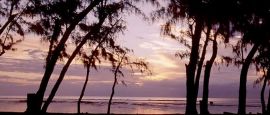Good swimming and diving are to be found along the Sous le Vent coast, especially at Saint-Gilles-des-Bains, which has a lagoon shielded from the open ocean by a reef. Though the reefs are protected habitats, scuba-diving and snorkelling are permitted. Surfing can be practised in Saint-Gilles, Saint-Paul and Saint-Pierre.
Reunion things to see and do
Tourist offices
Address: Maison Carrère, 14 rue de Paris, Saint-Denis, 97400 , Reunion
Tel: 02 6241 8300
www.reunion.fr
Inhale the scent of Réunion's exquisite tropical flowers, trees and fruit across the island; tours aim to show the visitor some of the many endemic species. Alternatively, head to the well-kept Jardin de l’Etat botanical gardens in the capital Saint-Denis, or the Jardin L’Eden tropical gardens at Saint-Gilles-des-Bains.
A special feature of Réunion is its so-called cirques – large volcanic valleys surrounded by mountains, creating natural amphitheatres of about 10km (6 miles) in diameter. The most beautiful is probably Salazie, with its magnificent waterfalls, especially those known as Le Voile de la Mariée (The Bride's Veil) near Hell-Bourg.
Réunion does not have extensive beaches, but those on the west coast are beautiful with yellow, black or white sands. Some of the best beaches are to be found at Saint-Gilles, Saint-Leu (where the Coral Turtle Farm is worth a visit) and Étang-Sale. These are mostly shallow coral, running out to a reef.
Saint-Denis, the capital, is surrounded by mountains on three sides and has several places of interest, including the Natural History Museum and the Léon Dierx Art Gallery with its collection of French Impressionist paintings. There are various temples, a mosque and a cathedral, a sign of the cultural and religious variety of the island population.
Réunion has over 600km (370 miles) of marked footpaths, and good climbing can be had among its volcanic peaks. Cilaos, once infamous as a refuge for escaped slaves, with impressive views of Le Bras Sec and Îlet à Cordres, rises approximately 1,220m (4,000ft). Piton des Neiges is the island’s highest point, while Mafate is its most secluded valley, still inaccessible by road.
The island's many communities gather together in Saint-Paul for the lively street market that occurs every Friday afternoon and Saturday morning. Situated along the seafront of the island’s first capital, stalls selling local produce and handicrafts abound, as do pop-up kitchens selling traditional Creole fare.
Réunion has some fantastic trekking opportunities, none more so than the path to Nez-de-Boeuf (Ox's Nose) mountain, which affords a splendid view over the Rivière des Remparts, 1,000m (3,300ft) below. Both the 8km-wide (5 miles) Enclos Fouque crater and the 2,632m (8,632ft) summit of the active volcano Piton de la Fournaise can be explored on foot.
Tamarind trees and large prehistoric-looking ferns dominate the Forêt de Bébour-Bélouve, in the centre of the island. Mosses hang from the tree branches in the humid air, while rare endemic birds dart among them. Best accessed from the town of Plaine-des-Palmistes, the forest is almost deserted on weekdays despite being a popular weekend retreat.
Réunion’s mixed heritage has left an island bursting with cultural spectacles. The island’s Tamil community, for instance, perform the cavadee (burden dance) during the colourful Hindu festival of Thaipusam in January or February. Taking place in Saint-André, it requires devotees to carry heavy burdens while performing additional acts of devotion such as skin piercing.
Do you have any Feedback about this page?
© 2025 Columbus Travel Media Ltd. All rights reserved. No part of this site may be reproduced without our written permission, click here for information on Columbus Content Solutions.








 You know where
You know where